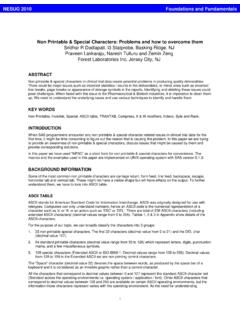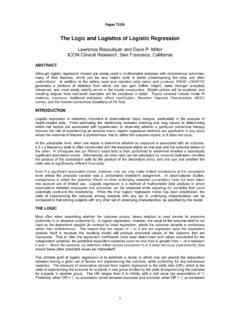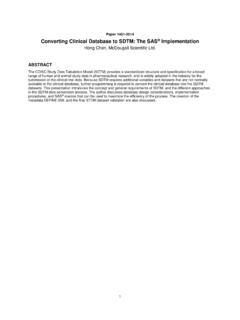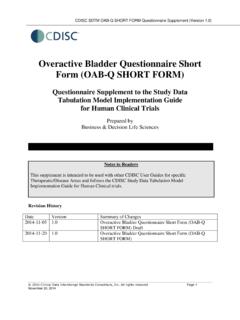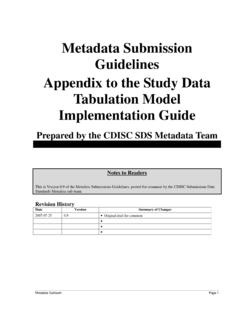Transcription of Evolution and Implementation of the CDISC Study Data ...
1 1 Paper FC08 Evolution and Implementation of the CDISC Study data tabulation model (SDTM) Fred Wood Principal Consultant, Octagon Research Solutions, and CDISC Tom Guinter Independent Consultant, and CDISC ABSTRACT The CDISC (Clinical data Interchange Standards Consortium) SDTM is a standard for submitting data tabulations to the FDA in support of marketing applications. In July of 2004, this standard became Study data Specification (1) referenced in the eCTD Guidance (2). In December of 2006, the FDA announced their intention to make the SDTM required by regulation (3).
2 This paper/presentation will provide an overview of the SDTM and the associated Implementation Guides, commonly referred to as the SDTMIG (SDTM Implementation Guide) and SEND (Standard for the Exchange of Nonclinical data ). Included will be the Evolution of the standard, the current status of the SDTM, strategic reasons for considering implementing the SDTM, and how the SDTM is used in the FDA review environment, including an overview of the tools used by the FDA to review SDTM data . INTRODUCTION CDISC BACKGROUND From its inception in 1997, CDISC has recognized the need for the establishment of standard data models to improve the process of electronic acquisition and exchange of clinical trials information for the benefit of all medical and pharmaceutical stakeholders.
3 This is reflected in the mission statement: " CDISC is an open, multidisciplinary, non-profit organization committed to the development of worldwide industry standards to support the electronic acquisition, exchange, submission and archiving of clinical trials data and metadata for medical and biopharmaceutical product development. The mission of CDISC is to develop and support global, platform-independent data standards that enable information system interoperability to improve medical research and related areas of healthcare.
4 " CDISC has four major standards: the Lab model (LAB) for the transfer of lab data from vendors to sponsors; the Operational data model (ODM) for the transfer of clinical trial data and metadata, including administrative data and audit trail; the Analysis data model (AdaM) for analysis datasets; and the SDTM for data tabulations. The LAB and ODM models are designed for the transfer of data from vendors and CROs to sponsors, while the ADaM and SDTM models apply to the submission of data to the FDA. CRTs Case Report Tabulations originated in FDA regulation of the late 1980 s.
5 Originally intended to allow sponsors to submit data tabulations to the FDA instead of copies of every subject CRF. Recently, as documented in the FDA Study data Specification (1), which is referenced in the eCTD Guidance (2), the definition has expanded to include data listings, patient profiles, data tabulations, and analysis datasets. Evolution OF THE SDTM The SDTM originated as the Submission data model (SDM), developed by the CDISC Submission data Standards (SDS) Team. The SDS Team is comprised of approximately thirty volunteers from industry.
6 Team meetings have also been regularly attended by three key FDA observers representing the Office of Business Process Support, Statistics, and Medical Review. Team members come from a cross-section of industry, including most major pharmaceutical companies, numerous small to mid-level pharmaceutical companies, CROs, and service providers. The SDS Team collaborates regularly through biweekly teleconferences, quarterly face-to-face meetings, and literally thousands of regular email communications, all in an effort to support the CDISC mission, to.
7 Improve medical research and related areas of healthcare. The concept that developed into the Study data tabulation model (SDTM) / Submission data Standards (SDS) was initially presented to the SDS Team by FDA liaisons in October, 2002. Prior to that time, the SDS Team had developed the Submission data Domain Models Version (v1, 2001), and Version (v2, early 2002), and was just about to publish All of these versions focused on safety domains. While the v1 and v2 data concepts had been well received by industry, it was recognized there were a couple of major shortcomings.
8 The revolutionary concept that the FDA proposed, termed Version 2 by the Team, addressed those major shortcomings by 1) providing a standard for all clinical trial data , not just safety data , and 2) providing a standard based on data modeling principles, rather than data management / operational database principles. This concept provided a consistent approach for modeling all clinical trial data across three primary data types (Events, Interventions, and Findings), allowing standard review tools to be developed.
9 The preliminary draft version of the SDTM concept was published in June of 2003 as the Submission data Domain Models Version , or better known as SDS The first version intended for Implementation was published as two documents in June of 2004: the SDTM (the model ), and the SDTMIG (the Implementation guide). During the period from June 2003 to June 2004, there were a number of enhancements leading to the final approved version, many the result of a joint FDA/industry pilot to test SDS , and two public review/comment periods.
10 Version of the SDTM was published in April of 2005, followed by Version of the SDTMIG four months later. REGULATORY EVENTS RELATED TO THE SDTM Shortly after the publication of the first production versions of the SDTM and the SDTMIG in June and July, respectively of 2004, the FDA recognized the SDTM as an approved method for submitting the data - tabulation component of Case Report Tabulations (CRTs) in the then-draft eCTD guidance. Health and Human Services (HHS) announced in the December, 2004 regulatory agenda (3) that the agency was moving towards requiring the submission of clinical trial data in a standard format.






